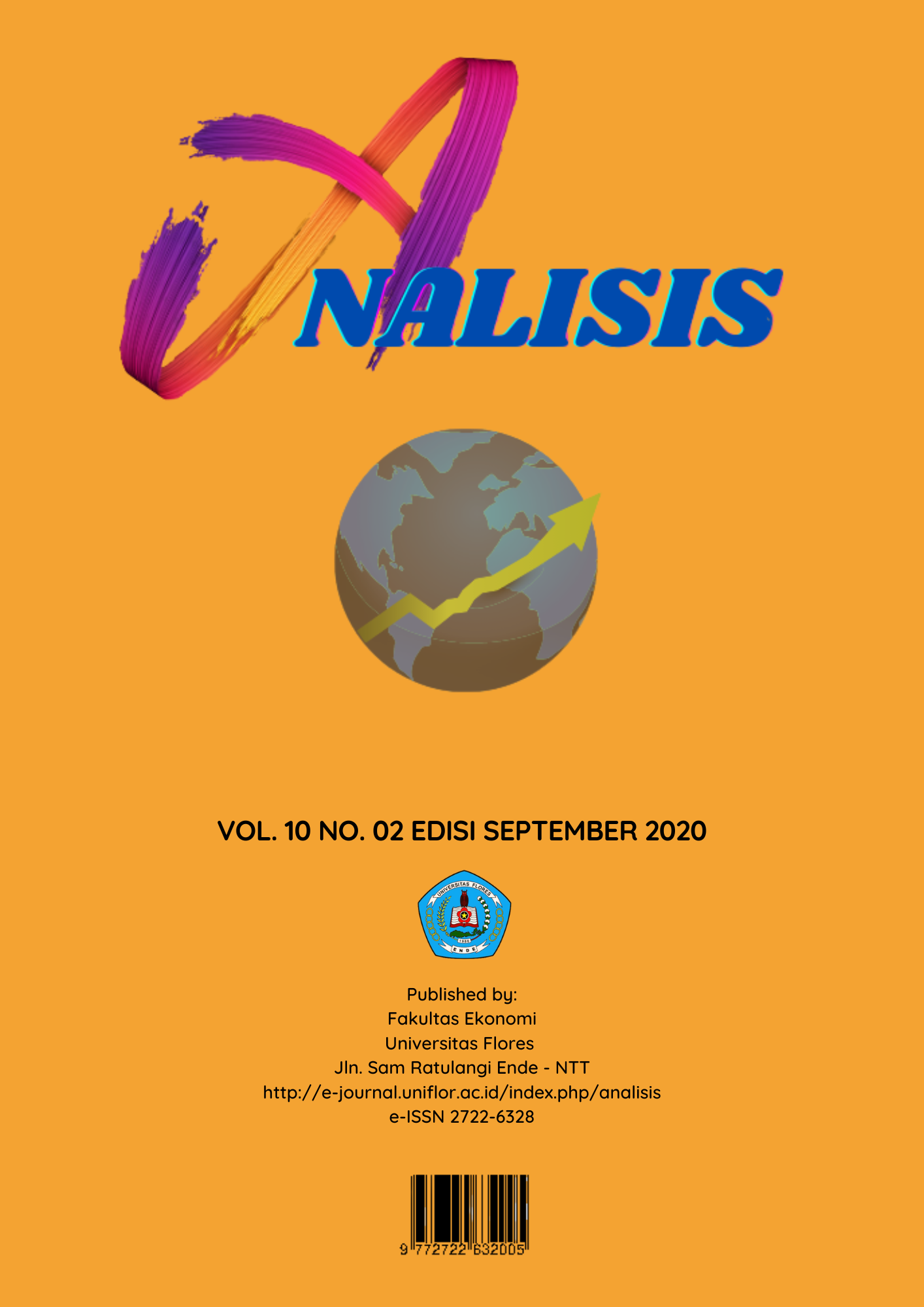Kajian Keberlanjutan Agribisnis Hortikultura di Kabupaten Sumba Barat
DOI:
https://doi.org/10.37478/als.v10i2.692Abstract
West Sumba is one of the regencies in Sumba island province of East Nusa Tenggara. Horticulture is a popular agricultural product there. The market potential for horticultural commodities in West Sumba is quite large but its production is still low. For this reason, the research was conducted with the aim of (1) knowing the sustainability status of horticultural agribusiness in West Sumba and (2) knowing the dominant attributes affecting the sustainability status of horticultural agribusiness development in the region. This is interesting to be examined since the sustainability is related to the ability of an area to increase production in the agricultural sector including the horticulture sub-sector. This study used the Multi-Dimensional Scaling (MDS) analysis method, which is modification of the Rapid Appraisal of the Status of Farming (RAP-farm) method. MDS analysis results show that (1) West Sumba Regency is in a fairly sustainable status for social and institutional dimensions while for the dimensions of ecology, economics and technology are in a less sustainable status and (2) the dominant attributes affecting each dimension are (a ) the ecological dimension is affected by the level of land slope and the level of erosion that occurs; (b) the economic dimension is affected by the management of horticultural products, the contribution to income per capita; (c) the social dimension is influenced by the existence of horticultural households and of government services; (d) technological dimensions by soil and water conservation technology and the application of technology; (e) the institutional dimension is influenced by conflicts between farmer groups, the availability of marketing institutions and the number of agricultural extension instructor.
Downloads
Keywords:
production, horticulture, agribusiness, attributes, dominant, sustainabilityReferences
Bungaran Saragih. 2010. Agribisnis paradigma baru pembangunan ekonomi berbasis pertanian. IPB Press, Bogor
Biro Pusat Statistik Sumba Barat. 2013. Kabupaten Sumba Barat Dalam Angka. BPS, Waikabubak
Biro Pusat Statistik Sumba Barat. 2015. Kabupaten Sumba Barat Dalam Angka. BPS Waikabubak
Biro Pusat Statistik. 2017. Kabupaten Sumba Barat Dalam Angka. BPS, Waikabubak
Biro Pusat Statistik Nusa Tenggara Timur. 2013. Provinsi Nusa Tenggara Timur Dalam Angka. BPS, Kupang
Biro Pusat Statistik Nusa Tenggara Timur. 2015. Provinsi Nusa Tenggara Timur Dalam Angka. BPS, Kupang
Biro Pusat Statistik Nusa Tenggara Timur. 2017. Provinsi Nusa Tenggara Timur Dalam Angka. BPS, Kupang
Direktorat Jenderal Hortikultura, 2014. Statistik hortikultura. Kementerian Pertanian, Jakarta
Eriyatno. 2012. Ilmu sistem: Meningkatkan integrasi dan dan koordinasi manajemen. Jilid 2 Ed ke-4. Penerbit Guna Widya, Surabaya
Fauzi A. 2002. Penilaian depresiasi sumberdaya perikanan sebagai bahan pertimbangan penentuan kebijakan pembangunan perikanan. Jurnal Pesisir dan Kelautan 4 (2): 36-49
Fauzi, A. dan S. Anna, 2005. Pemodelan sumber daya perikanan dan lautan untuk analisis kebijakan. Gramedia Pustaka Utama, Jakarta
Kotler P.2012. Manajemen pemasaran. Edisi ke-13.Penerbit Erlangga, Jakarta
Kepmen LH No.201Tahun 2004. Kriteria baku dan pedoman penentuan kerusakan mangrove. Kementerian Lingkungan Hidup, Jakarta
KEMENTAN RI.2014. Rencana Strategis Kementerian Pertanian 2015-2019. Kementerian Pertanian, Jakarta
Kuncoro M.2014. Otonomi daerah : Menuju era baru pembangunan daerah. Penerbit Erlangga, Jakarta
Kuncoro M. 2011. Metode riset untuk bisnis dan ekonomi : Bagaimana meneliti dan menulis thesis. Jakarta. Penerbit Erlangga, Jakarta
Nasrul W. 2012. Pengembangan kelembagaan pertanian untuk peningkatan kapasitas petani terhadap pembangunan pertania. Menara Ilmu, 29 (3) : 166 - 174
Pitcher, T. J. and D. Preikshot. 2001. Rapfish: A rapid appraisal technique to vvaluate the sustainability status of fisheries. Fisheries Research 49 (2001): 255-270
Pattimahu, Debby V. 2010. Kebijakan pengelolaan hutan mangrove berkelanjutan di Kabupaten Seram Bagian Barat, Maluku. Disertasi. Institut Pertanian Bogor, Bogor
Poerwanto R dan Susila DA. 2013. Teknologi hortikultura. IPB Press, Bogor
Rosidin U. 2015. Otonomi Daerah dan Desentralisasi. Pustaka Setia, Jakarta.
Saragih B. 2010. Pembangunan sektor agribisnis dalam kerangka pembangunan ekonomi Indonesia. Bappenas, Jakarta
Soekartawi, A Soeharjo, John L Dillon, J.Brian Hadaker. 2011. Ilmu usaha tani. UI Press, Jakarta
Suweda. 2011. Penataan ruang perkotaan yang berkelanjutan, berdaya saing dan berotonomi. J Ilmiah Teknik Sipil. 5 (2) : 113-122
Soekartawi. 2011.Agribisnis: Teori dan aplikasinya. Raja Grafindo Persada, Jakarta
Saida, Sabiham S, Sutjahja SH dan Widiatmaka. 2011. Analisis keberlanjutan usahatani hortikultura sayuran pada lahan lereng di Hulu DAS Jeneberang Sulawesi Selatan. J Matematika Sains dan Teknologi.12(1): 110-112
Sunyoto D. 2012. Dasar-dasar manajemen pemasaran. PT Buku Seru, Yogjakarta
Thamrin, Sutjahjo SH, Herison C dan Sabiham S. 2007. Analisis keberlanjutan wilayah perbatasan Kalimantan Barat-Malaysia untuk pengembangan kawasan agropolitan. J.Agro Ekonomi.25(2): 103-124
Theresia A dan Toto. 2014. Pembangunan berbasis masyarakat. Penerbit Alfabeta, Jakarta
Downloads
Published
Issue
Section
License
Copyright Notice
An author who publishes in ANALISIS agrees to the following terms:
- Author retains the copyright and grants the journal the right of first publication of the work simultaneously licensed under the Creative Commons Attribution-ShareAlike 4.0 License that allows others to share the work with an acknowledgement of the work's authorship and initial publication in this journal
- Author is able to enter into separate, additional contractual arrangements for the non-exclusive distribution of the journal's published version of the work (e.g., post it to an institutional repository or publish it in a book) with the acknowledgement of its initial publication in this journal.
- Author is permitted and encouraged to post his/her work online (e.g., in institutional repositories or on their website) prior to and during the submission process, as it can lead to productive exchanges, as well as earlier and greater citation of the published work (See The Effect of Open Access).





